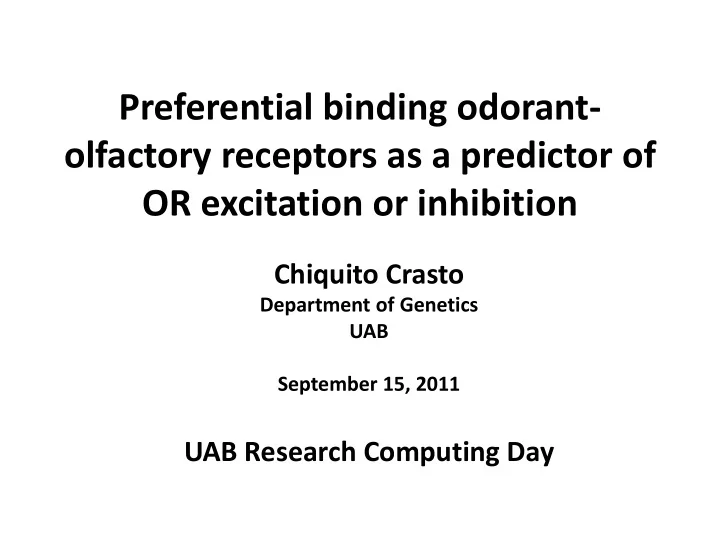

Preferential binding odorant- olfactory receptors as a predictor of OR excitation or inhibition Chiquito Crasto Department of Genetics UAB September 15, 2011 UAB Research Computing Day
Overview of the olfactory system http://www.sfn.org/index.cfm?pagename=brainbriefings_smellandtheolfactorysystem
Role of Olfactory Receptors in Odor Detection Malnic et al. (1999). Combinatorial Receptor Code for Odors. Cell, 5:713-723
Olfactory Receptors--Structurally • Rhodopsin-like class A GPCRs ( G TP-binding P rotein C oupled R eceptors) • 7 transmembrane helical domains • Extra-cellular N-terminus • Intra-cellular C-terminus • 6 interhelical loops – 3 extra-cellular – 3 cytoplasmic Top-down View Side View
Computational Modeling of Olfactory Receptors • Model-Building: Secondary structure Prediction – Secondary structure prediction to identify transmembrane helices – Hidden Markov Models to identify TM helices • TMHMM, HMMTOP and several other programs • Homology Modeling – Positioning the target protein sequence over a template and letting the structure resolve based on the template structure
Homology Modeling • Three possible templates are currently available – Bovine rhodopsin (PDB ID: 1u19) – Beta-adrenergic receptor (PDB ID: 2r4r, 2r4s & 2rh1) – Adenosine A2A receptor (PDB ID: 3qak, 2ydo & 2ydv)
Issues with using Rhodopsin as a template • The sequence identity between ORs and rhodopsin is 40% or less • The target-template matches have to take place based on structure not sequence • Helices in rhodopsin are longer than predicted OR helices • Loops in rhodopsin are shorter than OR loops • There are structure specific features for rhodopsin that need not arise in ORs
Rhodopsin (PDB Id: 1u19) Kink present in TM 7
Making the interior of the receptor biochemically (hydrophobically) feasible • The protein is surrounded by the lipid bi-layer of the cell membrane • The interior of the protein tends to be hydrophilic • Each helix then has to be repositioned such that its effective hydrophobicity is pointed in the “correct” direction— this step is post homology modeling • The following equation is used to determine the effective hydrophobicity Hydrophobicity profiles in G protein-coupled receptor transmembrane. helical domains. Crasto C. Journal of Receptor, Ligand and Channel Research, 2010. 3:123-133.
Effective hydrophobicity http://www.site.uottawa.ca/~turcotte/resources/HelixWheel/
Completing the OR model and introduction to docking • Loops are then added back to join the helices • The energy of the entire structure is minimized • Ligands that are known to activate a receptor (for ORs, these would be odorant molecules) — are then docked into the binding region of the receptor. This is static docking
Simulation Studies of Interactions between Olfactory Receptors and Odorant Molecules — tracing the path of an odor in a receptor There are disadvantages to static docking – Static docking provides a single snapshot of what occurs within a protein’s binding region – Protein-ligand interactions, and any other processes that follow from it, are always dynamic – These Interactions are also not restricted to one amino acid residue in the protein and the ligand – Different interactions might occur at different times during a ligand’s tenure in the proteins binding pocket, following docking
• One of the first papers on functional analysis of olfactory receptors • 14 mouse olfactory receptors were analyzed to test responses to 22 odorants (organic compounds) with different lengths and functional groups and for different concentrations
Role of Olfactory Receptors in Odor Detection Malnic et al. (1999). Combinatorial Receptor Code for Odors. Cell, 5:713-723
S79 (octanoic acid, heptanoic acid, nonanedioic acid, heptanol) S86 (nonanoic acid, heptanoic acid) Malnic et al. (1999). Combinatorial Receptor Code for Odors. Cell, 5:713-723
Raw file, post-docking GRAMM was used to dock the odorant ligands. (http://vakser.bioinformatics.ku.edu/main/resources_gramm.php) (Center for Bioinformatics, University of Kansas)
High Performance Computing Critical to Creating a properly simulated biological system • Olfactory receptor protein bound to a ligand • The 7 transmembrane domains of the receptor can be seen embedded into a lipid bilayer consisting of 230 palmitoyloleoylphosphatidylcholine (POPC) molecules and close to 22,000 explicit 3-site water molecules. • There are a more than 100,000 atoms being simulated in this system.
Water Lipid bilayer representing the plasma membrane Lipid bilayer representing the plasma membrane Olfactory receptor Protein Water
S79 Odorants that activate this Receptor nonanedioic acid heptanoic acid octanoic acid Ligand that does not activate heptanol
S86 Odorant that does not activate Odorant that activates nonanoic acid heptanoic acid
Study of the Interior of the binding region S86-nonanoic acid S79-nonanedioic acid
We can simulate an odor ligand “visiting” different binding sites. • This clip demonstrates an all-atom molecular dynamics simulation of a previously modeled human olfactory receptor, hOR17-209 docked with its activating ligand, iso- amyl acetate. • This clip shows the first 5 ns of simulation time in order to highlight ligand binding pocket sampling, the entire simulation lasted 10 ns. • The simulation was carried out on the UAB HPC cluster using Gromacs 4.5.4 and CHARMM (Chemistry at HARvard Molecular Mechanics) all-atom force field • Using 232 of the "gen3" compute nodes, the entire single- precision simulation took 8 and half hours to complete, having used 471 GFlops of computing power.
Movie of simulation • http://www.youtube.com/watch?v=z8UPl_wP 8K8
Acknowledgements • Peter C. Lai (School of Engineering, UAB) • Brandon Guida (Arizona State University) • Jing Shi (School of Public Health, UAB) • Lorra Hyland (School of Nursing, UAB) • Bharat Soni (School of Engineering, UAB) • Michael Hanby (School of Engineering, UAB) • Funding – NIH R21DC011068-01 , NIH R21AT004661-02S1, NIH 5UL1RR025777-03, NIHP30HD03985.
Thank you
Recommend
More recommend